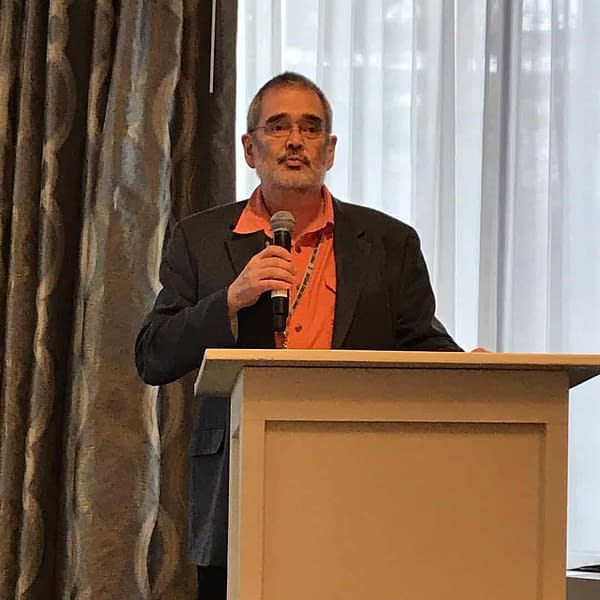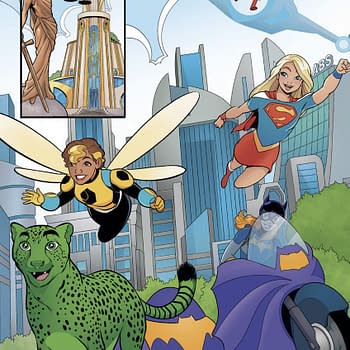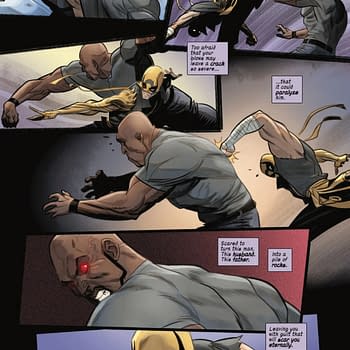Posted in: Comics | Tagged: Comics, comicspro, comicspro2019, entertainment
'We're Now In A Period Of Change' – Bob Wayne Explains the Rules in ComicsPRO Keynote Address
As Bleeding Cool previously noted, Bob Wayne is a tremendously respected comic book industry figure, especially among retailers. So his keynote speech at ComicsPRO in Charlotte, North Carlina this past weekend was much anticipated by comic book retailers in attendance. We were able to run one snippet earlier but today ComicsPRO issued the full text of his speech, which we reproduce below for everyone to enjoy.

Like with all humans, you can't get 100% of comics people to agree on much of anything beyond the basics of "I like to breathe" or "food good". So to save time, assume that when you disagree with me there was an unspoken modifier of "a lot of" or "almost all" that was left out… okay? Even without that warning, I'm sure there's something in here to annoy… almost all of you. But since a keynote is designed to be a conversation catalyst, I'm willing to take that risk. So, let's begin.
Growing up with the last name Wayne, learning to read primarily from 1958-1959 DC Comics, I'm sure at some point I dreamed I'd make a living in comics. So we'll start with this rule: be careful what you wish for. Although if you had told me in 1959 that in 2019 I'd be reflecting on a career that included setting the print runs for those same DC Comics…
I started selling new and back issues in 1973, as Seagate account #40. Which quickly taught me another rule: customers are not always right. Especially the ones who assume you're wrong about everything. Including on sale dates.
Editors, designers and creators are often in search of new publishing formats. Most longtime readers and retailers are not. They've invested in squeezing as many comics as possible into their homes (as have many of you with your stores) and new formats are a disruption. I learned this years ago when I was stocking the early 80s burst of original graphic novels from Marvel and DC. I also learned that a lot of customers weren't happy about paying $5.95 for what they believed was just an oversized comic book. You may recall the tabloid editions from the 70s? Among the many reasons you don't often see new ones anymore: they didn't fit on a spinner rack. They had to fight for space on a standard magazine rack. And they were so tall they often went to the back of that rack, or near the road atlas section. (Yes, people used to buy printed maps for when they were traveling.)
When you relaunch a character, you have to give the audience what they think they want, or something that the vast majority of them see as a clear change for the better. Change alone is not automatically an improvement. When Frank Miller took over the pencils on Daredevil, it was clearly better than what had come before it. When Marv Wolfman and George Perez revitalized the Titans, it may not have been what fans expected but it was clearly better. Relaunching every six months is almost always not going to be better.
Change usually comes slowly to comics. Sometimes the change is obvious only after it has occurred. Comics history shows us that most of the time when a publisher introduces a new concept, imprint or format it doesn't pan out. Your skepticism is warranted. Don't confuse desire with destiny. Just because a publisher or a creator has invested a lot of time and energy in a project does not guarantee its critical or commercial success. In the words of Mel Brooks: Hope for the best, expect the worst.
When Len Wein brought Alan Moore on to write Swamp Thing, I doubt he saw that as the first step that would eventually lead to Vertigo, or – I'd argue – to the modern incarnation of Image. Other important changes include the launch of Seagate, the introduction of the trade paperback, the archival reprint and the continuing evolution of the printing business. I'm sure you'll have your own lists.
I believe we're now in a period of change. Some of it may be dramatic. (By the way, I wrote the original version of this in December. Just in case you were wondering.)
It will be difficult. I expect a lot of you will survive. But you may need to change how you operate your businesses. And how you interact with your trading partners. You'll need to watch for changes from those partners, especially positive changes that will benefit you. (You may have already heard of some changes since you arrived at this meeting.) You'll need to encourage those changes, and you'll want to nurture them when they occur.
A sidebar to some of you: praising positive actions will help you more in the long term than a withering critique of how you would have done it better. I've been on the retailer side, and I've been on the publisher side. Trust me on this one.
One change in our industry to me is inarguably for the better, so let me be clear:I believe that inclusion is important to the future of comics, and I believe in the power of tolerance, diversity and representation. I don't believe that comics should be set in stone based on how they looked when any of us were children. I don't believe that most readers today would be interested in stories where Jimmy Olsen uses his signal watch to have Superman get a kitten out of a tree while a batch of generic white kids gather to cheer him. So don't misconstrue any of my remarks as support for any reactionary, back to mono movements within our community. That ain't me.
When I was a kid, and stick with me on this, to get the most out of each dime I would buy comics based on the number of costumed characters per title. (Yes, I outgrew that rule.)
The ones I read first were JLA and Adventure Comics with the Legion of Super-Heroes. In 1963 I was 9 years old when JLA 21 arrived, Crisis on Earth-One! Double the characters! JLA and JSA!
But it was continued next month. I really wanted that second part.
The following month I anxiously rode my bike on the appropriate day (because of course I had already started tracking the release schedule — when I was NINE) to get JLA 22 at the 7-11 near my house.
Got there. No 22. Without checking in with my mother – remember it's 1963 so no cellphones — I rode the other way, across a bridge over what is now Interstate 20 and along a narrow hilly road to the next convenience store, about 1 1/2 miles away. That was called Two Bucks, with a small store on one side and a giant liquor store on the other.
But still no JLA 22.
Another mile away up Interstate 35W was a new shopping center. 35W runs the length of the US from the Mexican border to the Canadian border. Kinda busy. At the shopping center was a GC Murphy variety store. They had the largest DC selection in town. Their comics were drop shipped from the printer in Sparta so they had them on sale earlier than everyone else. There it was. JLA 22, along with several other comics I wanted. I made my purchase, got back on my bicycle and rode the 2 1/2 miles back home, completing what was at that point the longest bike ride of my life.
Waiting for me was my frantic mother, who was clearly upset that I was gone for so long and amazingly unimpressed with my 5 mile trip. There was no disguising the GC Murphy bag holding the comics, so she had no doubt where I had been. So I was grounded and sent to my room. With my comics! All because of JLA 21 (and my singular focus on obtaining JLA 22).
I tell you this so I can remind you that no other sales channel in our industry has the passion for comics that you and your colleagues have. There are a few imbeds here and there scattered across other channels, but collectively you have the passion that connects directly to the readers. Publishers, freelancers – your work is more important to these retailers than it is to anyone else who might sell your work.
I'm not opposed to wider availability of comics at retail but during my professional career a lot of energy has been used trying to get comics into places like Toys r Us, Tower, Circuit City, Virgin, Blockbuster… And you know one of the big differences between those retailers and comics retailers? You're still here.
It's time to get back to basics: retailers who care about comics – selling them to readers – who care about comics.
In closing, I'd like to thank the comics retail community for your years of support and/or tolerance. I'd also like to thank the folks who hired me – Jenette Kahn, Paul Levitz, Dick Giordano & Bruce Bristow, the folks who continued to employ me, especially Dan DiDio & Jim Lee, the folks who were supposed to be "managing" me – hi there Steve Rotterdam – and the folks who worked with me during those 27 or so years from Rich Markow and Patty Jeres to Vince Letterio and Stuart Schreck.
And mostly a big thanks to my mother, for never throwing out any of my comics. Even after I scared the crap out of her!














